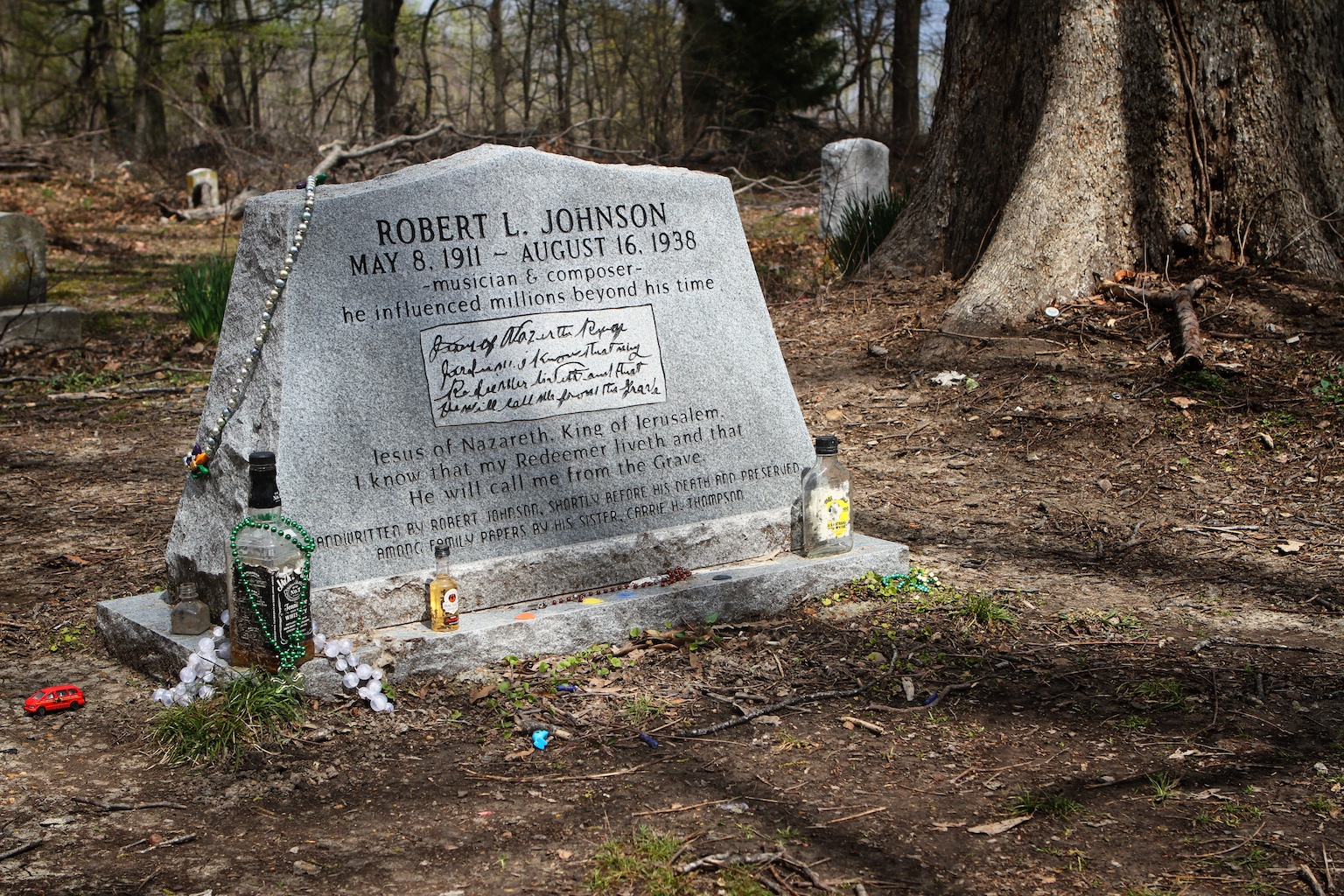Standing at the Crossroads
From Highway 61: A Father-and-Son Journey Through the Middle of America (W.W. Norton, 2003)
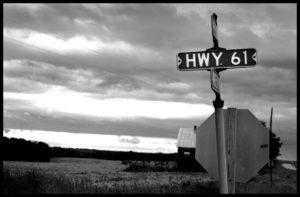
It’s a suffocating Sunday afternoon in the Mississippi Delta and my 19-year-old son and I are looking for a dead black man.
We head south of Oxford on Highway 7, over hills we see through a Jackson Pollock-like spray of butterflies and insects on the windshield of our Explorer. The road cuts across central Mississippi, back toward Highway 61. The corn, eyebrow high, already has tassles. Graham stocks the CD changer with appropriate music: Muddy Waters, Sunnyland Slim, B.B. King, Son House, Robert Johnson and Charley Patton.
Graham has also pulled out reams of computer printouts from his Internet research and his notes. While he drives, he asks me to mark key sites on our Mississippi road map. There are three graves – two marked, one unmarked – and Graham doesn’t want to take any chances. “We’re going to all three,” he announces. “One way or another, I want to be standing over him.”
We’re in the middle of a 6,000-mile road trip following Highway 61 from its beginning in Thunder Bay, Canada, to its end in New Orleans. Mississippi has so much music history that we’ve decided to take side trips from our main road. Marked on the map, they look like cross stitches.
“I think that unmarked grave is outside of Greenwood,” Graham says.
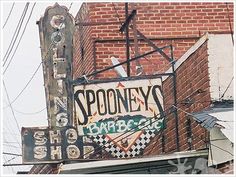 Greenwood’s got the post-nuclear look, largely void of people. We park downtown, but see few signs of life. After a couple blocks we come to Spooney’s Bar-Be-Que, where two young black men sit on the stoop, the CLOSED sign prominent in the glass door behind them. They don’t work there; they’re just copping some shade.
Greenwood’s got the post-nuclear look, largely void of people. We park downtown, but see few signs of life. After a couple blocks we come to Spooney’s Bar-Be-Que, where two young black men sit on the stoop, the CLOSED sign prominent in the glass door behind them. They don’t work there; they’re just copping some shade.
“Doin’ some bowlin’, buddy?” One of the men, the one in the pork-pie hat, points to my shoes.
“Hey, they’re the most comfortable shoes I own,” I say. “Actually, we’re just looking for directions. Do you know where Little Zion Church is?”
His face clouds and he turns to his buddy. “Little Zion?”
“Down this street right here,” his friend points. “Not too far down, you’ll see it, if it’s the one I’m thinking about.”
“All right, we’ll go looking for it.” I motion toward the door. “This place open later?”
The first guy shakes his head. “No, Spooney’s not open on Sunday. Not much is. You looking for a place to eat?”
He gives us directions to a place he says we’ll love not far away, but we go looking for the church first. We find it, but it’s in the middle of town, and the place we want is in the country.
“Look at the sign,” Graham says. “’New’ Zion. The place we want is Little Zion. They got mixed up.”
So we drive back downtown and easily find the place the two men recommended. When we step inside, we’re not disappointed so much by the place but that the guy would recommend it for us.
It’s like stepping into an Indiana diner. We’re back in the white-bread Midwestern world of ham loaf and persimmon pudding. All the customers are white.
“He probably thought this is where we’d be most comfortable,” I say.
“I would have been comfortable at Spooney’s,” Graham says.
All afternoon, on the way down from Oxford and in our few sightings of humans around Greenwood, we’d seen only black people. Now we were in the strongest concentration of white people we’d seen in the state.
“Kind of surprised to find this place in this town,” Graham says, “especially when they’re bumping country.” His eyebrows indicate the P.A. system.
The food is good and the sweetness of the pie tingles my jawbones. Eventually, a church-dressed black family shows up in the entrance of the restaurant and the hostess takes them behind the rope into the “section closed” area. Mandated or not, the South is still segregated.
As we’re paying, the hostess asks how we liked everything.
“Real good,” I say. “Say, would you mind if I looked at your phone book? We’re trying to find something, a church called Little Zion.”
She thumbs through the pages for me. “White church?” she asks, knitting her brow. At first I think she means the exterior color.
“I don’t think so.”
“Oh, I know the one you mean,” she says. “The one where that blues guy is supposedly buried.”
She takes out a napkin and draws us a map.
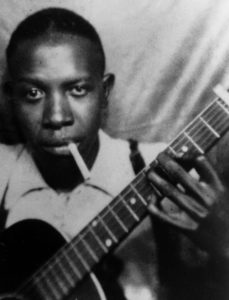
The ‘blues guy’ is Robert Johnson and we’re on his trail. In 1936 and 1937, he recorded 29 songs that provide much of the vocabulary of rock’n’roll. He was poisoned at a house party outside of Greenwood in 1938 and died within a few days.
The day before we’d been in Clarksdale, looking for his footsteps. Clarksdale is 70 miles south of Memphis, the Coahoma County seat and the largest city in the northern Mississippi Delta. Locals call it the capital of the Cotton Kingdom and snow-like fields radiate from the city limits. The town draws people from throughout the Delta; eventually, everybody comes to Clarksdale.
We arrive late on a Saturday afternoon. When we get to where 61 crosses Highway 49 – the crossroads, the place where Robert Johnson met the devil and gave over his soul for all eternity – we find a barbecue joint, a busy intersection by Clarksdale standards.
“Kind of bizarre,” I say to Graham. “You think with all of this traffic around here someone would have noticed the Prince of Darkness hanging out at the corner – and I’m talking Satan, not Neil Diamond.”
“I’m sure it was different back then,” Graham says.
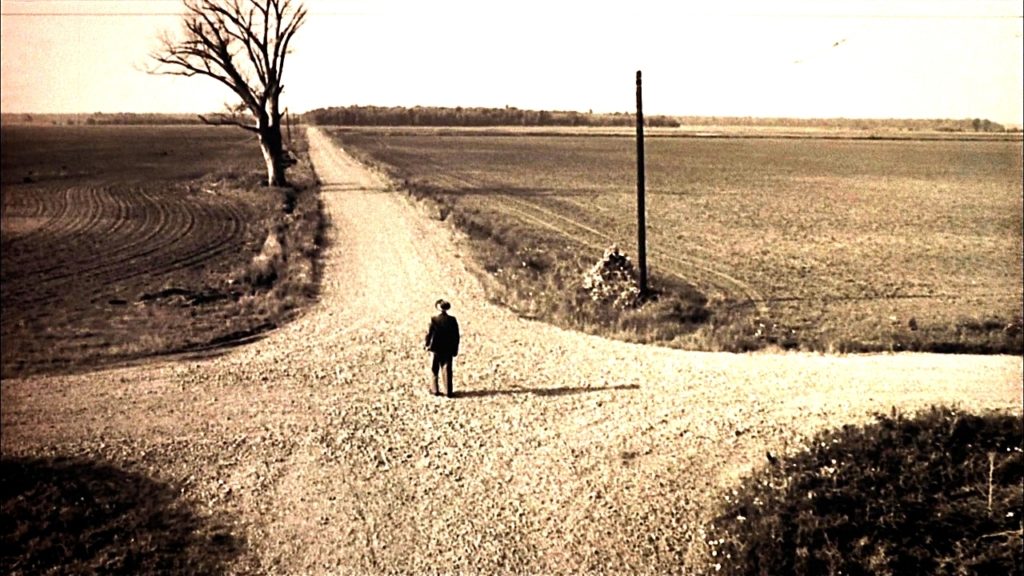
Legend says Robert Johnson came to this crossroads and sold his soul to the devil. That was the only explanation other musicians could give for his talent.
Johnson was illegitimate, born in 1911 to a woman named Julia Majors Spencer. Already married to a man named Charles Spencer, Julia raised her son in Hazelhurst, in southern Mississippi, and the boy grew up believing Spencer was his father and going by his surname. Charles Spencer had a falling out with some prominent local landowners and left Hazelhurst just ahead of a lynch mob. He escaped to Memphis, where he began using the name Charles Dodds. Eventually, he sent for his wife and children – despite the fact that he was living with another woman, with whom he had more children. Robert then became known as Robert Dodds. It wasn’t until he was a teenager that he learned that his true father was a drifter named Noah Johnson.
So he began calling himself Robert Johnson. As the family drifted back into Mississippi, to labor on plantations, he had no attraction to farm work. Only music interested him and he strung wires on the side of a barn and thus taught himself the guitar. But he wasn’t good enough to impress musicians who played juke joints and house parties. Son House and Willie Brown used to mock him. Then Johnson went away for a year in the early 1930s. When he returned, he asked to play with House and Brown. After listening to him, Son House said, “He must have sold his soul to the devil to play like that.”
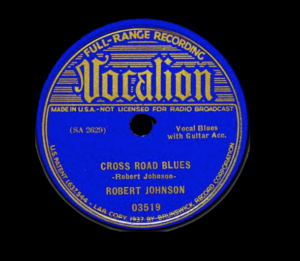 Today we’d call it hype. What Robert Johnson did to solidify his image and give himself some glamour was to identify with the devil. He watered and manured the story with songs such as “Me and the Devil,” “Hell Hound on My Trail” and “Cross Road Blues.”
Today we’d call it hype. What Robert Johnson did to solidify his image and give himself some glamour was to identify with the devil. He watered and manured the story with songs such as “Me and the Devil,” “Hell Hound on My Trail” and “Cross Road Blues.”
That crossroads image recurs in black culture. An earlier – and unrelated – singer named Tommy Johnson outlined the procedure: “You go to where . . . a crossroads is . . . . A big black man will walk up there and take your guitar and tune it.” When Satan gave you back the guitar, you could play better than anyone else – and he possessed your soul.
Johnson never directly mentioned the pact-with-the-devil stuff, but it’s a good story and it grew in the years after his death. Perhaps because so little was known about Johnson’s life something needed to be invented. What is known is that he was poisoned to death in 1938 by a jealous husband.
Somehow, through myth or hype or chamber-of-commerce boosterism, the 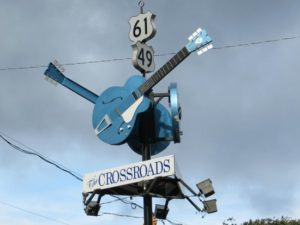 intersection of 61 and 49 has become the crossroads. At the crossroads there’s a signpost towering over the business neon – a pair of crossed blue guitars with replica road signs for 49 and 61.
intersection of 61 and 49 has become the crossroads. At the crossroads there’s a signpost towering over the business neon – a pair of crossed blue guitars with replica road signs for 49 and 61.
“I was hoping for something bleak and rural,” I say. “It reminds me when I went to New Beford, all psyched for the beauty and serenity of Cape Cod . . . and there was the Moby Dick Motel.”
We look around at the businesses and read the signs.
“Abe’s Bar-B-Q says it’s been here since 1924,” I say, “so if this is indeed the crossroads, Robert and the devil could have at least sealed their pact with a two-piece and a biscuit.”
Graham’s being literal. “It’s probably not the exact crossroads. They’ve probably moved the highway a little bit.”
Back outside of Greenwood on a hot Sunday afternoon, we get a stronger Robert Johnson scent than we had found in Clarksdale. The two-lane blacktop 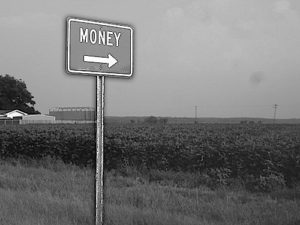 cuts north out of town.
cuts north out of town.
Turns out it’s also the road to Money, where a black teenager named Emmitt Till whistled at a white woman in 1955, and was murdered. Till was visiting from Chicago and didn’t know the Mississippi rules. One of his killers said after his acquittal, “What could I do? He thought he was as good as any white man . . . I’m no bully, I never hurt a niggah in my life. And when a niggah even gets close to mentioning sex with a white woman, he’s tired o’ livin’ . . . I’m gonna kill him.”
Till’s mother insisted on an open-casket at the funeral, so people could see the brutality visited on her 15-year-old son.
Maybe those killers used to eat where we just ate. The place advertised itself as “a dining tradition in the Delta for more than 50 years.”
In the car, heading out of town, Graham howls, he’s so happy. “We’re on the trail of the hellhound,” he yells. In his research he came across a National Park Service site devoted to the Delta blues that took its name from Robert Johnson’s haunting “Hell Hound on My Trail.”
The blacktop runs through cotton fields to the site of the church. A few miles north of town, we find it off on the west side of the road. We pull up to the church door, padlocked on a Sunday afternoon.
We’re working from a magazine clipping that gives the approximate location of the unmarked grave and has a picture of Rosie Eskridge, an 85-year-old woman, pointing at it with her walking cane. She remembers that back in 1938, her husband buried Robert Johnson under a spreading pecan tree.
There’s a small scattering of graves in the trees on the south side of the church yard, the graves tilting as if shaken by the wind, names washed off stone by time. It’s hard to walk through the graveyard without feeling that we’re disturbing the peace. Graham looks up, carefully examining the trees, holding the magazine clipping for reference. Finally, he finds the tree and a large depression underneath. “It’s probably in here,” he says. “You can see where the ground goes down. It looks like that’s the place.”
Are you really there, Bob? We’ve been listening to him in the car and for the first time, I’ve been profoundly struck by all the self references. There are the obvious “Me and the Devil” and “Hell Hound on My Trail.” But we’d been playing the music really loud and I kept hearing things I’d never heard before. I’d just bought a gold disc of King of the Delta Blues Singers and was astounded by the clarity. Apparently, Columbia Records mastered these discs from pristine old 78 rpm’s found since The Complete Recordings came out in 1990, making Robert Johnson a star all over again.
Listening to these newly discovered recordings in the car, it was like he was in the back seat. For the first time I hear the raw desperation in his plea to God: “Have mercy,” he begs, “Save poor Bob if you please.”
I didn’t hear him sing it first. Like millions of others, I came to Robert Johnson through Eric Clapton and the Rolling Stones. But when I finally did come to Robert Johnson, I think I felt some of the pain that tortured him.
“I haven’t thought about this in years,” I say to Graham. “You know when I got that album, King of the Delta Blues Singers?” He shakes his head. “Back when you were four, the day your mom left and went back to Indiana. We’d decided 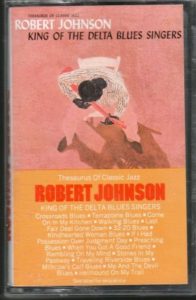 to separate. She needed to go away and clear her head and she wanted me to do the same. So she took you guys away early on a Saturday morning. By the middle of the afternoon, I was going crazy, I was so lonely. I went shopping and of course, that means the record store. And I found King of the Delta Blues Singers on cassette and I thought, ‘Man I’ve always heard about this record.’ Bob Dylan . . . Eric Clapton . . . all these people I loved always talked about Robert Johnson, so I figured it was time. I got it and took it home and I listened to it probably six times all the way through that weekend and I never talked to another human being those few days. I didn’t call my mother . . . I didn’t call anybody, didn’t talk to anybody. Maybe I said thanks to the record clerk, but that was it. I don’t think I’d ever been so lonely and depressed in all my life, just me and this dead man.”
I look down at the depression under the pecan tree. “If that is you, Bob.”
to separate. She needed to go away and clear her head and she wanted me to do the same. So she took you guys away early on a Saturday morning. By the middle of the afternoon, I was going crazy, I was so lonely. I went shopping and of course, that means the record store. And I found King of the Delta Blues Singers on cassette and I thought, ‘Man I’ve always heard about this record.’ Bob Dylan . . . Eric Clapton . . . all these people I loved always talked about Robert Johnson, so I figured it was time. I got it and took it home and I listened to it probably six times all the way through that weekend and I never talked to another human being those few days. I didn’t call my mother . . . I didn’t call anybody, didn’t talk to anybody. Maybe I said thanks to the record clerk, but that was it. I don’t think I’d ever been so lonely and depressed in all my life, just me and this dead man.”
I look down at the depression under the pecan tree. “If that is you, Bob.”
Graham doesn’t say anything; maybe he feels uncomfortable. Maybe it’s something he hasn’t wanted to think about either.
“It’s an odd compliment, I guess. He made something so good – art, I think we can safely call it – something so good that we can’t listen to it. I know I don’t listen to it often. I can’t. It’s almost too painful to hear.”
“I think because it’s unmarked, this must be the place,” Graham says. He looks around. “He’s here somewhere, I bet.”
“Maybe he belongs in an unmarked grave.” I turn to Graham, trying to smile. “Would you like to say a few words?”
He straightens up, looks around over to the church yard and the cotton fields, then back down at the ground. “Thanks for rock’n’roll, Dude.”
He picks up a pecan as a souvenir. “It’s odd that the grave is unmarked,” he says. “I mean, a man of his stature . . . .”
“Not sure he had any ‘stature’ at that point,” I say. “He’d put out some records, but he was just another bluesman of his time and there were so many of them they must’ve been running into each other on the sidewalk. ‘Scuse me, Blind Grapefruit. Didn’t mean to bump you there.’”
He laughs.
“Nice place to be buried, though.”
Graham looks again over to the cotton fields across the little road. “He’s found peace. I’d want to be buried in a place like this.”
We find a silk carnation blown off of another grave into the gravel drive and put it at the depression under the tree. “It’s the best we can do for you, Bob.”
Graham’s back behind the wheel, heading toward the second grave site. He’s asking me for directions to Quito, a little village south of Greenwood.
Johnson’s last performance was at Three Forks store. The store was moved to a place within a half mile of this other burial site. Graham’s turned up the music and that haunting voice booms out of the speakers and over the cotton fields as he guides the War Wagon to grave number two.
Had I heard Robert Johnson before that weekend, or had I just heard of him? Since high school, Eric Clapton’s “Crossroads” had been one of my favorite songs, with its glorious chaos and pain. When I finally heard Robert Johnson that horrible weekend years later, I was struck by the spare sound of “Cross Road Blues.” Everyone has a crossroads. I was lucky to have Robert Johnson provide a soundtrack for mine.
We’d found evidence of a campfire behind the Little Zion Church. No doubt legions of blues enthusiasts had put that place on their tour maps after the story broke about the unmarked grave. The next place, down in Quito, was more well known. There was a headstone for Johnson there. Still, finding these places isn’t easy.
“Mississippi is just screwed when it comes to road signs,” I say. “And they name one of the biggest lakes in the state after Governor Ross Barnett, who tried to keep James Meredith out of Ole Miss.”
“It’s weird,” Graham says, “because it’s so beautiful and I like so many of the people.”
“It’s a ‘terrible beauty.’ It’s like Ireland that way. Look at the cotton, the trees along the road.”
We negotiate through Greenwood and an industrial park south of town and we’re back out in the sparse countryside. Glancing over the map with all of Graham’s notes, I tell him America needs a national cemetery for bluesmen, like Arlington for the military. I get my desired effect – a laugh from my son – but I’m not joking. The visit to Little Zion Church shook me. For a moment, I was a thousand miles and 15 years away, listening to Robert Johnson in a dark house, all alone. No pictures of Robert Johnson had been published back then and I had no idea what he looked like. He was just that sweet but hard-edged voice.
“Do you feel close to Robert Johnson, driving down these little roads?” I ask. “This little road was here when he was alive. And it’s obvious it hasn’t even been re-paved.”
“And these railroad tracks,” he points. “They were here then. Maybe he walked them.”
We’re turned around, trying to find Quito. Part of the problem is the roads we want are too small to be numbered on the map. As if understanding our problem, Robert stops singing “Me and the Devil Blues” and offers a spoken aside: “Now, babe, I don’t care where you bury my body when I’m dead and gone.” I laugh and rewind the disc to hear the line again.
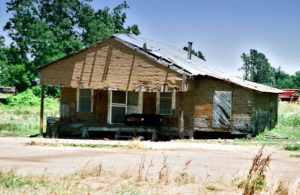
“That’s Three Forks,” Graham says. It’s a little, unmarked store and roadhouse at the corner of a country lane. “It wasn’t here when he played here his last night. They moved it here. But the church ought to be over here.” He turns down a dirt road.
“You ought to be a reporter,” I tell him. “I always thought I had a good memory for details, but you kick my ass.”
A quarter mile down the road, up on a small knoll we find Payne’s Chapel. But for the cross, the building could be an auto parts store on a country road. There are several cars parked in the church yard already and a group of young black men gather on the steps. Maybe they’re waiting for someone with keys.
I introduce myself to a guy in a form-fitting burnt-orange T-shirt. He tells me his name is Xavier Manning.
“I bet you get tired of people like us,” I say, and I’m about to tell him why we’ve come to his church on this Sunday afternoon.
“No problem,” he says, smiling. He turns and points. “He’s right over there.”
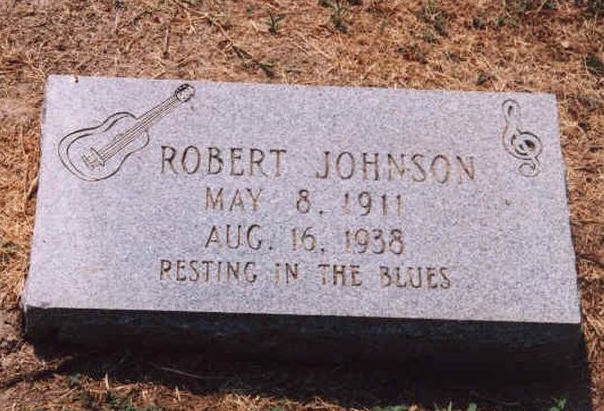
It’s a simple flat marker: “Robert Johnson. May 8, 1911 – August 16, 1938. Resting in the Blues.” Flowers, guitar picks and quarters – for the tip cup, of course – rest on the marker. The grave, like the rest of the cemetery, is well tended. Fading sunlight fingers through the trees at the edge of the cemetery. No signs indicate “Robert Johnson Over Here,” though this is probably the most-visited of his gravesites.
“This is pretty and all,” Graham says. “But I don’t feel him here. I think he was at the other place.”
“But this is closest to where he died, right?”
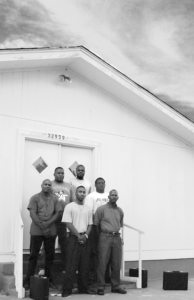
A couple more guys have gathered on the church step and we introduce ourselves and thank them for letting us visit. One of the new guys we’ve just met, Sean Ward, seems puzzled by our presence.
Xavier explains. “They’re here to see Robert Johnson’s grave.”
“Who?” Sean asks.
“Robert Johnson,” Xavier says.
“He’s buried here?” Sean seems shocked.
“Right over there,” says another guy, Mark Ramsay. “Go find it.”
“Thanks for letting us look,” I tell them. “Is it disruptive, people coming around looking for his grave all the time?”
Xavier dismisses it. “Oh, we get it, but it doesn’t disrupt anything.” “Did you know your church is on the Internet?”
Xavier and his friends seem startled, so we tell them about the pictures of the church and the grave and the directions, which turned out to be pretty accurate. “So you guys having a meeting here? You the church board or something?”
“Mason’s Lodge,” Xavier says. “Just our weekly meeting.”
The sign is gone from Three Forks country roadhouse. It’s got that tan fake-brick shingle on the side and my vandal son finds a small, torn piece in the dirt in front of the porch, dusts it off and announces he’s keeping it for a souvenir. The windows are boarded, but the place has obviously been visited by blues scavengers. We look through a small opening in the boards covering the windows and imagine Robert Johnson standing on the sagging wooden floor inside, playing his guitar.
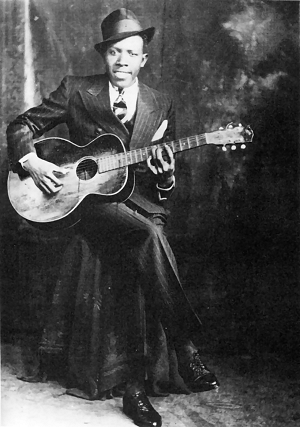
There are a lot of stories of Robert Johnson’s death, but they all focus on this place. He’d been in Greenwood for a while, playing at house parties and juke joints like Three Forks. He’d been seeing a married woman in the area and her husband owned Three Forks. By all accounts, Johnson wouldn’t have cared about that. If he wanted a woman, didn’t matter if she was married.
The last night he played here, other musicians performed as well – Honeyboy Edwards, Houston Stackhouse and Sonny Boy Williamson. Williamson remembered that during a break someone offered Johnson a drink from an open bottle. Williamson grabbed it from him and warned him never to drink from an open bottle. Johnson was furious and when offered another drink, Johnson took it.
There was strychnine in the whiskey. He was taken to the home of a friend and survived the night, but he contracted pneumonia and three days later he died. The death certificate lists “no doctor” as the cause of death. As part of the legend – the same legend about selling his soul to the devil – it’s said that in his dying hours, Johnson crawled on all fours and barked like a dog in his agony.
Sunset. Two miles further down the road, another churchyard, another marker.
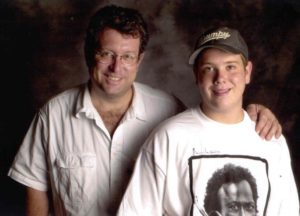
We pull off the road in respectful silence, slowing so our tires don’t spit gravel into the yard. It’s another nondescript church, like Payne’s Chapel, with two bolted doors and a modest steeple. There’s a miniature Washington Monument with a quote from “Me and the Devil Blues” carved into the granite: “You may bury my body down by the highwayside.” His instructions were followed to the letter, except that the body probably isn’t here. The part of the monument facing the church has the photo-booth portrait of Robert Johnson, lips dripping a cigarette, and underneath his name is carved, “His music struck a chord that continues to resonate. His blues addressed generations he would never know and made poetry of his visions and fears.”
There are other graves nearby. There’s been a funeral earlier today – dirt still mounded, no time yet for rain to smooth the clods into mud. Silk and plastic flowers are stuck into the ground.
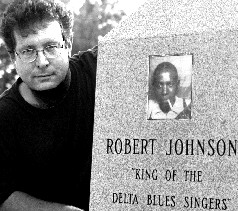
As with the Payne’s Chapel site, visitors have left guitar picks and quarters on Johnson’s marker. We pick up some obvious litter. I remember a song from Bob Dylan’s first album, the one made when he was 20 but trying to sound older: “See That My Grave is Kept Clean.”
Across the road is a small creek and we see some fishermen on the bank about a quarter of a mile down. Highway 7 is a few feet away, but no cars pass while we wander the gravesite. We don’t talk, both probably listening to internal music. I’m hearing Robert Johnson murmur, “Can’t you hear that wind howl?”
Again we whisper. I put my arm around Graham. “What do you think, Boy?”
He smiles. “It’s beautiful, Dad. ‘Bury my body down by the highwayside . . .’ If he isn’t here, he should be.”
“And the creek right across the road, right out here in the middle of nowhere. Wherever he is, I hope he’s resting.”
Wherever he is. As a young man, he lost a wife and infant in childbirth. It was then that he lashed out at God, and the stories of deals with the devil followed. And then came the music.
I’d visited three places today and if Robert Johnson hasn’t found peace, then maybe no peace is to be found.
The grave in the Little Zion churchyard is no longer unmarked. A monument was erected in late 2001. The inscription made no reference to the blues.
